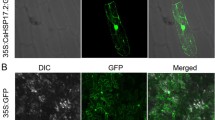Abstract
Bacterial cold shock proteins (CSPs) function as RNA chaperones that destabilize RNA secondary structures. A quadruple mutant of Escherichia coli (cspA, cspB, cspG, and cspE) displays a cold-sensitive growth phenotype. Plant cold shock domain (CSD) proteins have been shown to complement the cold-sensitive phenotype of the E. coli mutant and to share a function with E. coli CSPs as RNA chaperones. This methodology, which is detailed here, can be utilized to reveal or probe the RNA chaperone activity of heterologous proteins.
Access this chapter
Tax calculation will be finalised at checkout
Purchases are for personal use only
Similar content being viewed by others
References
Phadtare S, Tyagi S, Inouye M, Severinov K (2002) Three amino acids in Escherichia coli CspE surface-exposed aromatic patch are critical for nucleic acid melting activity leading to transcription antitermination and cold acclimation of cells. J Biol Chem 277:46706–46711
Kloks CP, Spronk CA, Lasonder E et al (2002) The solution structure and DNA-binding properties of the cold-shock domain of the human Y-box protein YB-1. J Mol Biol 316:317–326
Weber MH, Volkov AV, Fricke I et al (2001) Localization of cold shock proteins to cytosolic spaces surrounding nucleoids in Bacillus subtilis depends on active transcription. J Bacteriol 183:6435–6443
Barria C, Malecki M, Arraiano CM (2013) Bacterial adaptation to cold. Microbiology 159:2437–2443
Graumann P, Wendrich TM, Weber MH et al (1997) A family of cold shock proteins in Bacillus subtilis is essential for cellular growth and for efficient protein synthesis at optimal and low temperatures. Mol Microbiol 25:741–756
Jiang W, Hou Y, Inouye M (1997) CspA, the major cold-shock protein of Escherichia coli, is an RNA chaperone. J Biol Chem 272:196–202
Wang N, Yamanaka K, Inouye M (1999) CspI, the ninth member of the CspA family of Escherichia coli, is induced upon cold shock. J Bacteriol 181:1603–1609
Yamanaka K, Fang L, Inouye M (1998) The CspA family in Escherichia coli: multiple gene duplication for stress adaptation. Mol Microbiol 27:247–255
**a B, Ke H, Inouye M (2001) Acquirement of cold sensitivity by quadruple deletion of the cspA family and its suppression by PNPase S1 domain in Escherichia coli. Mol Microbiol 40:179–188
Sasaki K, Imai R (2011) Pleiotropic roles of cold shock domain proteins in plants. Front Plant Sci 2:116
Karlson D, Nakaminami K, Toyomasu T, Imai R (2002) A cold-regulated nucleic acid-binding protein of winter wheat shares a domain with bacterial cold shock proteins. J Biol Chem 277:35248–35256
Nakaminami K, Sasaki K, Kajita S et al (2005) Heat stable ssDNA/RNA-binding activity of a wheat cold shock domain protein. FEBS Lett 579:4887–4891
Nakaminami K, Karlson DT, Imai R (2006) Functional conservation of cold shock domains in bacteria and higher plants. Proc Natl Acad Sci U S A 103:10122–10127
Imai R, Kim MH, Sasaki K et al (2013) Cold shock domain proteins in Arabidopsis : functions in stress tolerance and development. In: Yoshida M, Matsumoto N, Imai R (eds) Plant and microbe adaptations to cold in a changing world. Springer, New York, pp 131–142
Kim JS, Park SJ, Kwak KJ et al (2007) Cold shock domain proteins and glycine-rich RNA-binding proteins from Arabidopsis thaliana can promote the cold adaptation process in Escherichia coli. Nucleic Acids Res 35:506–516
Kim MH, Sasaki K, Imai R (2009) Cold shock domain protein 3 regulates freezing tolerance in Arabidopsis thaliana. J Biol Chem 284:23454–23460
Sasaki K, Kim MH, Imai R (2007) Arabidopsis COLD SHOCK DOMAIN PROTEIN2 is a RNA chaperone that is regulated by cold and developmental signals. Biochem Biophys Res Commun 364:633–638
Kwak KJ, Park SJ, Han JH et al (2011) Structural determinants crucial to the RNA chaperone activity of glycine-rich RNA-binding proteins 4 and 7 in Arabidopsis thaliana during the cold adaptation process. J Exp Bot 62:4003–4011
Masui Y, Coleman J, Inouye M (1983) Multipurpose expression cloning vehicles in Escherichia coli. In: Inouye M (ed) Experimental manipulation of gene expressions. Academic, New York, pp 15–32
Acknowledgements
This work was supported in part by grants from the Japan Society for the Promotion of Science (KAKENHI Scientific Research B 19380063) and NARO project 112g0 (Wheat and Soybean Biotechnology) to R.I. We thank Dr. Linda Jewell for her comments on this manuscript.
Author information
Authors and Affiliations
Corresponding author
Editor information
Editors and Affiliations
Rights and permissions
Copyright information
© 2015 Springer Science+Business Media New York
About this protocol
Cite this protocol
Kim, MH., Imai, R. (2015). Determination of RNA Chaperone Activity Using an Escherichia coli Mutant. In: Boudvillain, M. (eds) RNA Remodeling Proteins. Methods in Molecular Biology, vol 1259. Humana Press, New York, NY. https://doi.org/10.1007/978-1-4939-2214-7_8
Download citation
DOI: https://doi.org/10.1007/978-1-4939-2214-7_8
Published:
Publisher Name: Humana Press, New York, NY
Print ISBN: 978-1-4939-2213-0
Online ISBN: 978-1-4939-2214-7
eBook Packages: Springer Protocols




